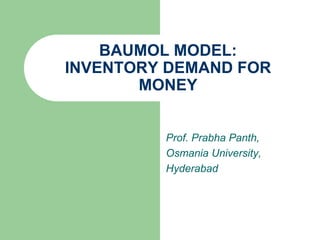
Baumol's model of demand for money
- 1. BAUMOL MODEL: INVENTORY DEMAND FOR MONEY Prof. Prabha Panth, Osmania University, Hyderabad
- 2. Demand for Money Keynes assumed Transaction and Precautionary DM = f(Y), so changes in interest rate has no impact on them But Baumol showed that rate of interest also affects Transaction motive for holding money. -- Holding cash in hand gives high liquidity. – But there is loss of interest as the money is not deposited in a bank. Therefore rate of interest also affects Transaction Demand for Money. 2
- 3. The Baumol Model Baumol model describes money demand in terms of a trade off between liquidity and rate of return. Assume that consumer can keep his income in the form of either cash in hand or in savings account deposits. Cash pays no nominal interest. The savings account pays interest rate i, this is the opportunity cost of holding cash. 3
- 4. Consumer’s choice The consumer has to decide between keeping cash (liquidity) but no interest, and putting it in a saving deposit – earns interest but less liquid. If he keeps in savings deposit, he has to spend time and money to go to the bank to withdraw cash. This is the opportunity cost of keeping money in the bank. The consumer has to decide on the optimum allocation of his funds – between cash and savings deposits. 4
- 5. Cost of Money Management M: M = cost of withdrawal (NF) + cost of interest foregone due to holding cash (iM) Baumol’s Model: PY = total nominal spending, done gradually over the year i = nominal interest rate on savings account N = number of trips consumer makes to the bank to withdraw money from savings account F = cost of a trip to the bank (e.g., if a trip takes 15 minutes and consumer’s wage is Rs.120/hour, then F = Rs.30) 5
- 6. Average money holdings is a function of N or number of trips to the bank. This has to be minimised. If N=1, then the consumer keeps all his income in the form of cash. He spends it gradually throughout a given time period, say a year or a month, His expenditure is constant over the time period. The money or cash in hand falls at a constant rate, till it becomes zero at the end of the time period. Cost of holding money 6
- 7. Baumol model: The demand for money Assume that consumer keeps all income in the form of cash. Then he only goes once to the bank to withdraw cash. In one year, his average money holdings = Y/2 Y Money holdings Time 1 year N = 1 Average = Y/ 2 7
- 8. By keeping all Y as cash, he loses interest. Supposing he keeps half his Y in savings account, Then he has to make 2 trips to withdraw money. So on average he has Y/4 cash in hand. Y Time11/2 N = 2 Y/ 2 Average = Y/ 4 If N = 3, then 3 trips to the bank and average cash holdings = Y/6 8
- 9. The cost of holding money In general, average money holdings = Y/2N Foregone interest = i (Y/2N ) Cost of N trips to bank = FN total cost = Y i F N N 2 Given Y, i, and F, consumer chooses N to minimize total cost 9
- 10. N Cost Foregone interest = iY/2N Cost of trips = FN Total cost Finding the cost-minimizing N For any value of N, the height of the red line equals the height of the blue line plus the height of the green line at that N. Equilibrium is at X, with N* optimum number of trips. N* X 10
- 11. total cost = Y i F N N 2 2 0 2 i Y F N Take the derivative of total cost with respect to N, set it equal to zero: Solve for the cost-minimizing N* 2 * i Y N F 11
- 12. The Money Demand Function The Baumol-Tobin money demand function: ( ) = ( ) 2 / , ,d Y F M P L i Y F i Money demand depends positively on Y or income and F or foregone interest, and negatively on i. 12
- 13. Summary of Baumol’s model – A transactions theory of money demand, stresses “medium of exchange” function – Real money demand (Md/P) depends positively on spending (Y), negatively on the nominal interest rate (i), – Positively on the cost of converting non-monetary assets to money (F) – It forms the Micro foundation for the LM curve model. 13
